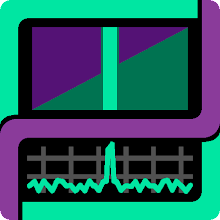Setup
- Record or load a BPSK modulated signal into baudline.
- In the Input Channel Mapping window set the transform to blip Fourier and the space to phase.
- Zoom the spectrogram timebase axis down to the bit level.
- Set the Windowing to Gaussian and adjust the beta value to taste.
- View, measure, explore, ...
blip Fourier phase
The spectrogram display of the blip Fourier transform in phase space.
 The carrier is at 1000 Hz and the modulated bits of the BPSK signal are clearly visible. The discontinuities represent 180° phase transitions and not absolute phase. Other interesting features are the fractal like structure that surrounds the carrier and the fabric of the noise floor to the right which is composed of interwoven phase worms. The elements of phase space are rich and quite literally complex in nature.
The carrier is at 1000 Hz and the modulated bits of the BPSK signal are clearly visible. The discontinuities represent 180° phase transitions and not absolute phase. Other interesting features are the fractal like structure that surrounds the carrier and the fabric of the noise floor to the right which is composed of interwoven phase worms. The elements of phase space are rich and quite literally complex in nature.periodicity bars
Baudline's periodic bars are used to measure the periodicity of the phase transitions. Fine adjustment for exact alignment was accomplished with the up and down arrow keys. The bars aligned on the 180° phase transitions represent the modulated symbols. Click on the spectrogram image for a full size version that will show the periodicity bars in full detail.

Note the overlaid delta 0.016 second period value.
 baud rate
baud rateThe delta selected measurement window displays a higher accuracy period value and a convenience 1 / period = Hz calculation. In BPSK there are only two possible phases (0° and 180°) so the symbol rate equals the baud rate (1 bit/symbol) which the periodicity bars measured to be 63 Hz or 63 baud.
demodulated bits
Use the spectrogram's periodicity bars as a symbol clocking aid to manually demodulate the bit stream. Reading off the delta phase transitions corresponds to the bit string: 010100110010110100011010 or it's inversion 101011001101001011100101 since the true starting bit is unknown. The decoding of the meaning of these 24 bits is left as an exercise for the reader.
Conclusion
The remarkable revelation is that the blip Fourier transform has no a priori knowledge of the carrier frequency, baud rate, or even the PSK modulation scheme. It simply is blind phase locking and allowing a visual demodulation of the signal. Demodulating the actual bits from a BPSK signal is just a byproduct and a neat trick.
Phase consists of half of the spectrum. Half. Previous analysis tools have discarded this phase information and focused solely on magnitude. Use the baudline signal analyzer and see the other half of what you've been missing.

2 comments:
Blip T the 1024 Qam...
Abdab? Day?
You should baudline the surf in the cove...
BPSK, have got to start somewhere. Just taking baby steps. 1024-QAM in due time.
Wait till you see me blind phase lock an abalone!
Post a Comment